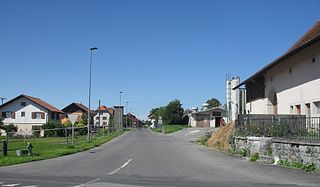
Cremin is a former municipality in the district Broye-Vully in the canton of Vaud in Switzerland. In 2017 the former municipalities of Cremin, Brenles, Chesalles-sur-Moudon, Forel-sur-Lucens and Sarzens merged into the municipality of Lucens.

Lucens is a municipality in the Broye-Vully district in the canton of Vaud in Switzerland. In 2017 the former municipalities of Brenles, Chesalles-sur-Moudon, Cremin, Forel-sur-Lucens and Sarzens merged into the municipality of Lucens.

Chanéaz is a former municipality in the district of Jura-Nord Vaudois of the canton of Vaud in Switzerland. The municipalities of Chapelle-sur-Moudon, Correvon, Denezy, Martherenges, Neyruz-sur-Moudon, Peyres-Possens, Saint-Cierges, Thierrens and Chanéaz merged on 1 January 2013 into the new municipality of Montanaire.
Saint-Cierges is a former municipality in the district of Gros-de-Vaud in the canton of Vaud in Switzerland. Its name refers to Saint Cyriacus, who is the town's patron saint. The municipalities of Chapelle-sur-Moudon, Correvon, Denezy, Martherenges, Neyruz-sur-Moudon, Peyres-Possens, Saint-Cierges, Thierrens and Chanéaz merged on 1 January 2013 into the new municipality of Montanaire.

Thierrens is a former municipality in the district Gros-de-Vaud in the canton of Vaud in Switzerland. The municipalities of Chapelle-sur-Moudon, Correvon, Denezy, Martherenges, Neyruz-sur-Moudon, Peyres-Possens, Saint-Cierges, Thierrens and Chanéaz merged on 1 January 2013 into the new municipality of Montanaire.

Bussy-sur-Moudon is a municipality in the district Broye-Vully in the canton of Vaud in Switzerland.
Chapelle-sur-Moudon is a former municipality in the district Gros-de-Vaud in the canton of Vaud in Switzerland. The municipalities of Chapelle-sur-Moudon, Correvon, Denezy, Martherenges, Neyruz-sur-Moudon, Peyres-Possens, Saint-Cierges, Thierrens and Chanéaz merged on 1 January 2013 into the new municipality of Montanaire.

Chavannes-sur-Moudon is a municipality in the district Broye-Vully in the canton of Vaud in Switzerland.

Correvon is a former municipality in the district of Gros-de-Vaud in the canton of Vaud in Switzerland. The municipalities of Chapelle-sur-Moudon, Correvon, Denezy, Martherenges, Neyruz-sur-Moudon, Peyres-Possens, Saint-Cierges, Thierrens and Chanéaz merged on 1 January 2013 into the new municipality of Montanaire.

Curtilles is a municipality in the district Broye-Vully in the canton of Vaud in Switzerland.

Denezy is a former municipality in the district of Gros-de-Vaud in the canton of Vaud in Switzerland. The municipalities of Chapelle-sur-Moudon, Correvon, Denezy, Martherenges, Neyruz-sur-Moudon, Peyres-Possens, Saint-Cierges, Thierrens and Chanéaz merged on 1 January 2013 into the new municipality of Montanaire.

Forel-sur-Lucens is a former municipality in the district Broye-Vully in the canton of Vaud in Switzerland. In 2017, the former municipalities of Forel-sur-Lucens, Brenles, Chesalles-sur-Moudon, Cremin, and Sarzens merged into the municipality of Lucens.

Neyruz-sur-Moudon is a former municipality in the district Gros-de-Vaud in the canton of Vaud in Switzerland. The municipalities of Chapelle-sur-Moudon, Correvon, Denezy, Martherenges, Neyruz-sur-Moudon, Peyres-Possens, Saint-Cierges, Thierrens and Chanéaz merged on 1 January 2013 into the new municipality of Montanaire.

Oulens-sur-Lucens is a former municipality in the district of Broye-Vully in the canton of Vaud in Switzerland.
Peyres-Possens is a former municipality in the district of Gros-de-Vaud in the canton of Vaud in Switzerland. The municipalities of Chapelle-sur-Moudon, Correvon, Denezy, Martherenges, Neyruz-sur-Moudon, Peyres-Possens, Saint-Cierges, Thierrens and Chanéaz merged on 1 January 2013 into the new municipality of Montanaire.

Rossenges is a municipality in the district of Broye-Vully of the canton of Vaud in Switzerland.

Sarzens is a former municipality in the district Broye-Vully in the canton of Vaud in Switzerland. In 2017 the former municipalities of Sarzens, Brenles, Chesalles-sur-Moudon, Cremin, Forel-sur-Lucens merged into the municipality of Lucens.

Sottens is a former municipality in the district of Gros-de-Vaud in the canton of Vaud in Switzerland.

Syens is a municipality in the district of Broye-Vully in the canton of Vaud in Switzerland.
Chesalles-sur-Oron is a former municipality in the district of Lavaux-Oron in the canton of Vaud in Switzerland. The municipalities of Bussigny-sur-Oron, Châtillens, Chesalles-sur-Oron, Ecoteaux, Oron-la-Ville, Oron-le-Châtel, Palézieux, Les Tavernes, Les Thioleyres and Vuibroye merged on 1 January 2012 into the new municipality of Oron.























